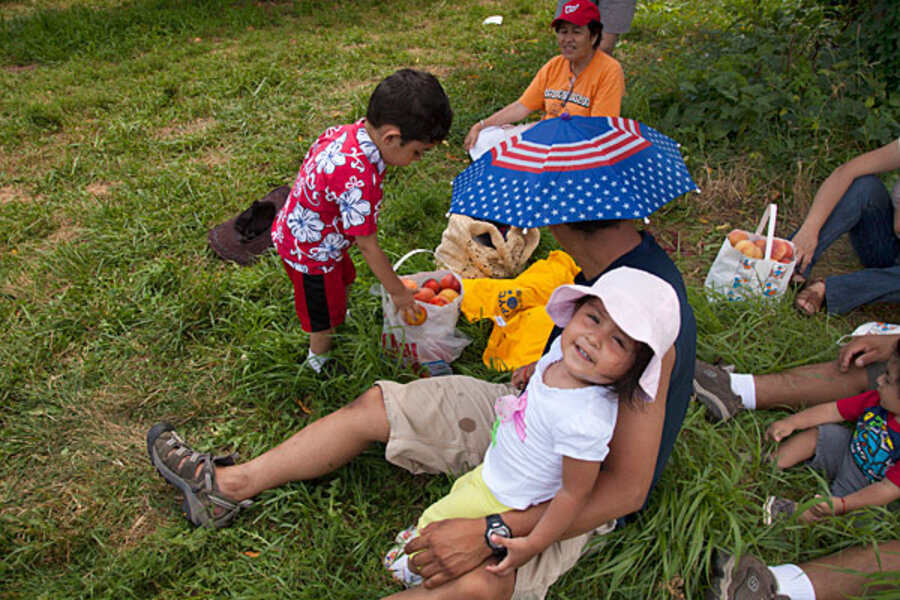Who are America's immigrant kids? Not who you think, study suggests.
Loading...
A new study is exploding some old myths about immigrant children in America – and revealing the challenges they still face.
Children of immigrants were more likely than their peers born to US natives to have a parent with a secure job; less likely to be born underweight, to die as an infant, or to have a physical impairment; and less likely to be disconnected from school or a job between the ages of 16 and 19.
When it comes to enrolling in preschool and being covered by health insurance, however, children of immigrants fared worse among blacks, whites, Hispanics, and Asians, according to a report released Wednesday by the Foundation for Child Development in New York.
In a nation where 1 out of 4 children has an immigrant parent, a better understanding of how these children fare compared with their peers in nonimmigrant families is starting to emerge.
“The families are good strong families when they come to the US, and yet we’re not supporting them in the ways that we could and should in regard to education and health care,” says Donald Hernandez, lead author of the report and a sociology professor at Hunter College and The Graduate Center, City University of New York.
It’s important to look at diverse demographic groups because these children are the “first nonmajority generation,” Mr. Hernandez says, with fewer than half of US children projected to be white by 2018. The changes are driven by immigration from Latin America, Africa, Asia, and the Caribbean. “Ninety percent of children in immigrant families are US citizens, so these children really are our children,” he says.
Among some of the findings in today’s report, “Diverse Children: Race, Ethnicity, and Immigration in America’s New Non-Majority Generation”:
- The median family income for black children with US-born parents was the lowest, at $29,977, followed by Hispanic children with immigrant parents at $33,396. The highest incomes were for Asian children with US-born parents, at $79,848.
- Fifty percent of black children with US-born parents had a parent with secure employment, compared with 64 percent of black children of immigrants and 61 percent of Hispanic children (of both immigrant and nonimmigrant parents). The other groups ranged from 77 to 81 percent.
- Among children of immigrants, 19 percent of Hispanics and 15 percent of blacks lacked health insurance coverage.
- Hispanic children with immigrant parents enrolled in preschool at a rate of 37 percent, compared with 42 percent of those with US-born parents. The rest of the groups ranged from 50 to 55 percent.
- Fourth-grade reading proficiency levels on the Nation’s Report Card were compared across households where English was the primary language or not, because data on immigration of parents was not available. Eighty-four percent of black children whose primary language was not English could not read proficiently, but the same was true of 83 percent of blacks whose families did speak English. For Hispanics the figures were 83 percent for those whose primary language was not English compared with 79 percent for those whose families did speak English; for whites, 65 percent versus 55 percent; for Asians, 51 percent for both groups.
Public policymakers at times make assumptions that were valid 20 years ago without taking into account how dramatically demographics have changed, says William Frey, a demographer at the Brookings Institution in Washington. “Sometimes people think of young black or Hispanic kids as being somewhere far away … in a barrio disconnected from them. But [the numbers show] this is a big part of America’s future, everywhere.”
He adds that for all the debate over immigration reform, one issue not often discussed is “what happens with the second or third generation who are already here. How do we get them equipped to be productive members of our labor force?”
One recommendation in the report is to remove the exclusion of undocumented immigrants from the new health insurance exchanges being set up across the country. Not only is that bad for the parents’ health, says Hernandez, but it could leave children who are US citizens uncovered, if their parents are afraid to sign them up because of their undocumented status.
But proposals to open up more public benefits for undocumented workers, including easier pathways into college and financial aid for children brought to the United States when they were young, known popularly as DREAMers, have proved controversial.
It’s also not the first report to urge more investment in access to preschool education. Earlier this year, the Equity and Excellence Commission released a set of recommendations to the US Department of Education, included a boost for preschool, and President Obama has made that one of his signature issues this year.





